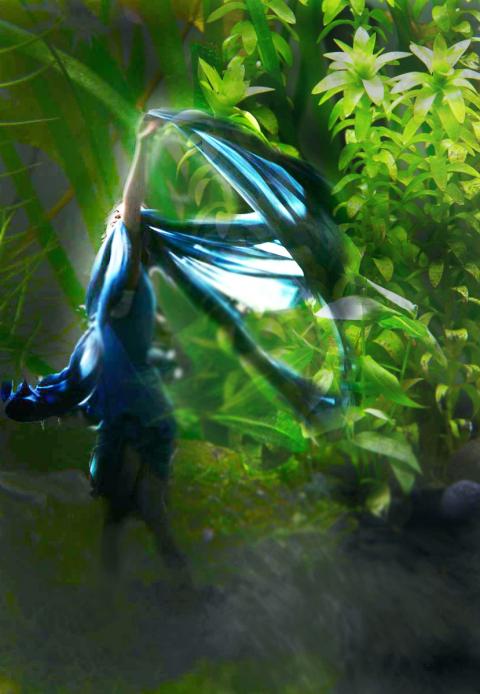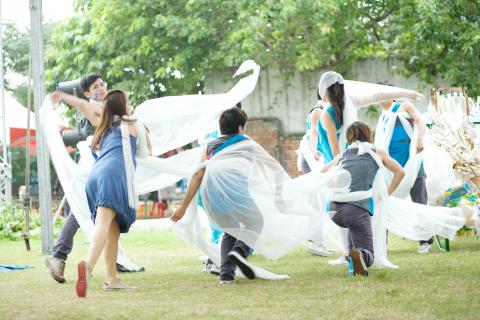Dance and choreography are often described in terms of liquidity or fluidity of movement. This afternoon a group of young Taiwanese dancers will use their bodies to focus attention on the most precious fluid of all — water — and the need for safe drinking water for everyone, as part of a 24-hour worldwide event, Global Water Dances.
The project is the brainchild of 11 Laban Movement analysts who were inspired by a dance and the environment conference they attended in England in 2009. (Labanotation and Laban Movement Analysis were first developed by Rudolf Laban in the early 20th century as a way of describing, notating and recording human movement used by dancers, physical therapists and others.) The 11 all had experience with Laban’s idea of Movement Choirs, which are events aimed at creating social cohesion through community dances. Planning for tomorrow’s event began last year with the creation of a Web site and networking.
Global Water Dances begins in Pacific Rim nations and travels westward around the world, involving dancers, musicians and other artists in 60 cities. It can be followed online at globalwaterdances.org.

Photo Courtesy of Chen Yi-shu, Dancecology
The Taiwanese portion has been organized by a two-year-old troupe called Dancecology (舞蹈生態系創意團隊), founded and directed by Peng Hsiao-yin (彭筱茵), a former member of the Neo-Classical Dance Company (新古典舞團) who received her MFA from the Graduate Institute of Choreography at Taipei National University of the Arts (TNUA). She wanted to move beyond the traditional limits of stage-bound performance to focus on environmental theater, hence the thinking behind the troupe’s name — dance plus ecology, or Dancecology.
Since the group’s founding, it has performed at the 2009 Kuandu Arts Festival, the Taipei Fine Arts Museum, Juming Museum and, earlier this year, at the Taipei International Flora Expo. It was selected as the 2009-2010 artist-in-residence at the TNUA KD Art Culture Industry Innovation Incubation Center. The company joined the Global Water Dances lineup at the end of last year.
Peng’s work is usually site specific and today’s show will take place in the viewing area in front of Zhuwei Wharf (竹圍碼頭) in Tamsui, which is a short walk along the bikeway from the Zhuwei MRT Station (竹圍捷運站). It is also the site of Plum Tree Creek (樹梅坑溪), which was the inspiration for Peng’s portion of the program.

Photo Courtesy of Chen Yi-shu, Dancecology
In her program notes Peng said the creek, a branch of the Tamsui River, was once the only source of fresh water in the Zhuwei area, but rapid development has left it little more than a gutter. Starting last year, several historians, artists and local residents banded together to draw awareness to the creek’s plight and push for its restoration.
Eight dancers and two musicians will be performing this afternoon, joined by children from Zhuwei Elementary School for sections three and four (“The Water Dance” and “Confluence”), which are the global collective portions of the program.
Peng choreographed the first two sections: “Flowing with Water,” which she said will gather the energy of participants and flow along with the Plum Tree Creek, and “The Story of Plum Tree Creek,” telling how humans change and damage nature.
To encourage people to get involved in helping to save the creek and protect Taiwan’s environment, audience members will be invited to join the dancers at several points during the show. For example, when the dancers who are portraying the creek are being polluted by the dancers who are playing the role of garbage, “we’ll invite the audience to save them,” Peng said. In “Confluence,” the troupe’s dancers will lead the audience in a group dance. In “The Water Dance,” dancers and volunteers will perform the same moves that are being danced around the world today.
In addition, after the show audience members will be invited to take a pledge to treasure water resources and reduce daily water pollution. Those who do will be invited to add their handprints to a long roll of paper.
The idea is to turn the paper into a “river of hands,” Peng said.
Dancecology notified us after the paper went to press that because of the advent of Typhoon Meari, their performance will be postponed until next Saturday, July 2, at 5pm at the same location.

Most heroes are remembered for the battles they fought. Taiwan’s Black Bat Squadron is remembered for flying into Chinese airspace 838 times between 1953 and 1967, and for the 148 men whose sacrifice bought the intelligence that kept Taiwan secure. Two-thirds of the squadron died carrying out missions most people wouldn’t learn about for another 40 years. The squadron lost 15 aircraft and 148 crew members over those 14 years, making it the deadliest unit in Taiwan’s military history by casualty rate. They flew at night, often at low altitudes, straight into some of the most heavily defended airspace in Asia.

Taiwan’s democracy is at risk. Be very alarmed. This is not a drill. The current constitutional crisis progressed slowly, then suddenly. Political tensions, partisan hostility and emotions are all running high right when cool heads and calm negotiation are most needed. Oxford defines brinkmanship as: “The art or practice of pursuing a dangerous policy to the limits of safety before stopping, especially in politics.” It says the term comes from a quote from a 1956 Cold War interview with then-American Secretary of State John Foster Dulles, when he said: ‘The ability to get to the verge without getting into the war is

Beijing’s ironic, abusive tantrums aimed at Japan since Japanese Prime Minister Sanae Takaichi publicly stated that a Taiwan contingency would be an existential crisis for Japan, have revealed for all the world to see that the People’s Republic of China (PRC) lusts after Okinawa. We all owe Takaichi a debt of thanks for getting the PRC to make that public. The PRC and its netizens, taking their cue from the Chinese Communist Party (CCP), are presenting Okinawa by mirroring the claims about Taiwan. Official PRC propaganda organs began to wax lyrical about Okinawa’s “unsettled status” beginning last month. A Global

Like much in the world today, theater has experienced major disruptions over the six years since COVID-19. The pandemic, the war in Ukraine and social media have created a new normal of geopolitical and information uncertainty, and the performing arts are not immune to these effects. “Ten years ago people wanted to come to the theater to engage with important issues, but now the Internet allows them to engage with those issues powerfully and immediately,” said Faith Tan, programming director of the Esplanade in Singapore, speaking last week in Japan. “One reaction to unpredictability has been a renewed emphasis on